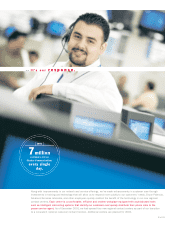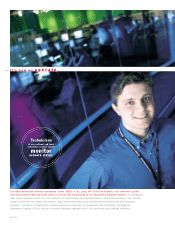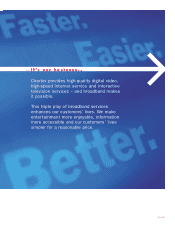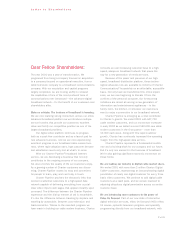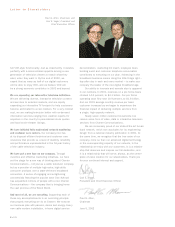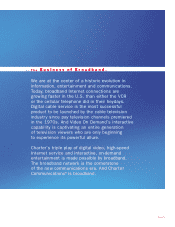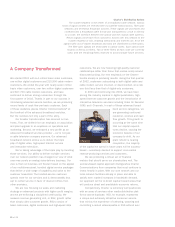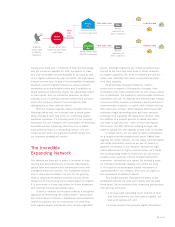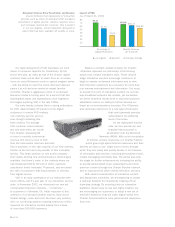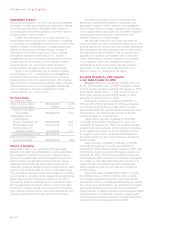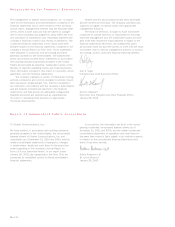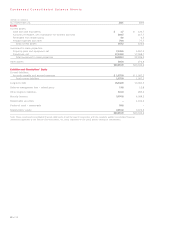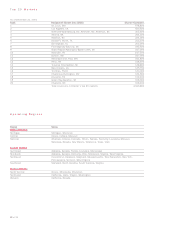Charter 2001 Annual Report Download - page 15
Download and view the complete annual report
Please find page 15 of the 2001 Charter annual report below. You can navigate through the pages in the report by either clicking on the pages listed below, or by using the keyword search tool below to find specific information within the annual report.
13 of 25
to have developed a comprehensive cable modem
support and service infrastructure that includes
sophisticated technical support to help customers with
complex networking and computing questions.
We’ve made big strides not only in responding to
service questions, but in protecting our networks from
the very disruptions that can affect customer satisfac-
tion in the first place. By developing a remarkable new
network monitoring infrastructure, we’ve attained
tremendous electronic visibility and control over
our networks.
Our national Network Services Operations Center
(NSOC) is the centerpiece of an electronic system that
allows technicians to monitor key components of our
advanced broadband network. If a broadband data router
anywhere within our core network isn’t performing up
to specifications, for instance, technicians working
in our 32,000 square foot NSOC in St. Louis will be
able to detect the problem, alert local technicians,
and confirm that the device has been properly adjusted –
before a single cable modem customer is affected
by a disruption. In conjunction with the NSOC, our
Regional Operations Centers (ROCs) conduct a similar
detection regimen within the local video and Internet
data networks, all the way from the headend to the
home. New equipment will allow ROC technicians
a level of monitoring so precise they’ll be
able to measure voltage levels
of stand-by power supplies
in each node or evaluate
resources available to
any one of the neighbor-
hoods they serve. That’s
important, because keeping
local network resources
running smoothly is a key
to delivering broadband
services, including advanced
two-way services such as
interactive television.
Through 2001, systems serving approximately 60
percent of Charter’s customers had been linked to the
ROC/NSOC surveillance network, and more are on the
way. Early results are excellent. In our Greenville, SC
service area, shortly after introducing our new networking
monitoring and service management tools, we were
able to improve a key measure of signal quality signifi-
cantly and to reduce network-related customer calls by
32 percent. Those results exemplify the three key bene-
fits of our investment in network operations centers:
• improve the customer experience;
• reduce the number of occasions in which we’re
required to “roll trucks” to respond to service
problems; and
• reduce the number of trouble calls to our call
centers, thus freeing our customer-contact
associates to devote more time to sales
and upgrades.
In short, we’ve introduced a new level of sophis-
tication and efficiency in the way we detect and solve
network problems, and in the way we handle a growing
array of customer calls. The service infrastructure
behind our broadband network is now as advanced
as the network itself.
The Interactive
Household
Charter Communications is leading
the broadband industry in bringing
long-awaited interactive television
and digital communications services
to the home. Not only are we
delighting customers with a new
range of possibilities, we’re culti-
vating a new standard for a whole
new generation of television users.
Our Robust Broadband Platform
Charter’s upgrade to a state-of-the-art architecture
is nearing completion. By the end of 2002, nearly
85 percent of Charter’s customers will be served
by a two-way capable network. Upon completion
of the upgrade, nearly 90 percent of Charter’s
customers will be served by a two-way capable,
750 megahertz or higher network.
870 MHz: 44%
750 MHz: 41%
550 MHz: 6%
< 550 MHz: 9%
Planned 2002 Capacity
(percent of Charter customers)


